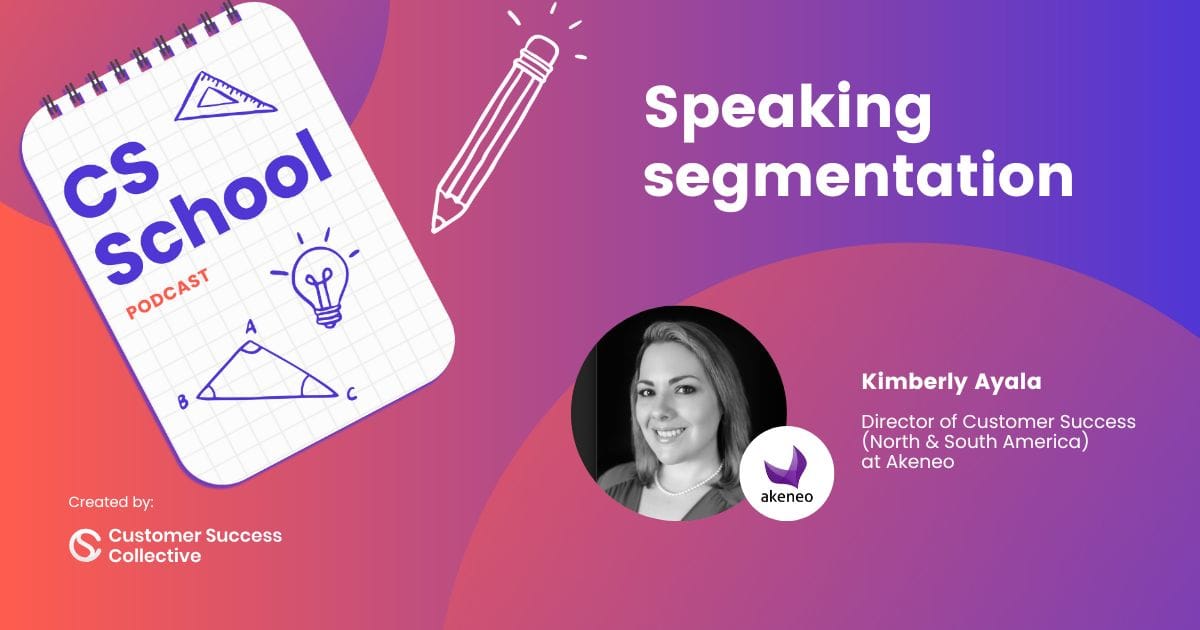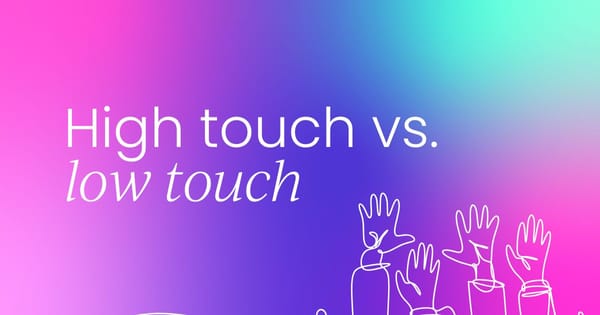Even the most accomplished salesperson will agree that you’re not out of the woods with the close of a sale. Anything can happen after the point of conversion to cause a client to churn (unsubscribe) once they become a fully-fledged customer.
That’s why customer success teams go above and beyond to engage with their different customer types in the most appropriate way to maintain customer retention rates.
High touch vs. low touch customer success
As a Customer Success Manager (CSM), figuring out the best way to interact with customers can be challenging. You don’t want to bombard them with onboarding emails or product updates, nor do you want to leave them in the lurch without human guidance. Every customer has a different persona, and might not have the same need for your product.
This is where high-touch and low-touch customer engagement models come into play.
In this article, we’re going to take a deep dive into the whats, hows, and whys surrounding high-touch and low-touch engagement models, specifically:
- Differences between high-touch and low-touch models
- The definition of high-touch customer success
- The definition of low-touch customer success
- The rules of customer segmentation
- Whether low touch can ever feel like high touch
TL;DR
| Engagement model | Description | Pros | Cons |
|---|---|---|---|
| High touch |
|
|
|
| Low touch |
|
|
|
The key differences between high-touch and low-touch engagement
Most SaaS companies will have devised the most suitable way to engage with their customers. And it boils down to how frequently they contact their customers. From processes like customer onboarding, upgrading plans, and general account management, there needs to be a route of communication with your customer. But how?
Customers who require a lot of interaction and less reliance on digital engagement with a company can be considered "high touch." It’s hands-on.
If they need less human interaction, then they can be classed as low-touch, relying more on self-service resources like knowledge bases, chatbots, and automated emails. There might still be some human involvement, but it’s limited.
To take this a step further, there's tech touch," which is fully automated and takes this a step further – it's fully automated and scalable, meaning there’s almost zero human interaction. Think AI-driven nudges, in-app guidance, automated lifecycle emails, and predictive analytics to drive engagement.
So, all tech-touch is low-touch, but not all low-touch is tech-touch. Low-touch can still involve some human oversight, whereas tech-touch is purely digital.
Both high-touch and low-touch engagement models are types of services personalized toward the individual needs of the customer. Some customers require more hands-on contact from a company, while others prefer battening down the hatches and experiencing the product independently.
Deducing what type of engagement model your business should adopt will depend on your product type – and the customer’s own needs, too.
A closer look at high-touch customer success
Ordinarily, being a high-touch customer means you have a personal, one-to-one (1:1) relationship with a dedicated expert consultant: a Customer Success Manager assigned to your account.
Guided by a CSM, the customer will be walked through how to use the product during their onboarding period. While a high-touch engagement model will be less dependent on digital engagement with a company, this type of customer will still utilize videos and digital aides to assist their onboarding process.
However, the key difference between this and a low-touch engagement model is that these customers aren’t solely limited to digital assistance.
For example, if you were to purchase a program or tool, for your department that’s a little complicated, you’d want an in-depth understanding of the software to fully maximize its value to your company.
For more complex pieces of software, customers must have a CSM on hand to show them all of the amazing features of the product. The result? A satisfied customer who is less likely to churn.
From the point of sale, there will be a handover from the sales representative to the CSM, who will create an implementation plan tailored to the customer’s goals. The definition of success is unique to every customer, in that you’re defining what success means by what the customer wants, and not via a predetermined quota.
Being a high-touch client means that you require regular guidance from your CSM to answer questions that arise during onboarding and continue throughout the relationship.
High-touch customers necessitate a greater demand on your customer success team, as it requires more personal and frequent interactions. There’s no avoiding this, it’s going to be a bit more expensive, as you’ll have to factor in the cost of the CSM’s labor.
Balancing new and existing clients
Acquiring new logos is becoming more of a challenge for SaaS businesses looking.
Typically in SaaS companies, about 75% to 80% of revenue is generated from a only 20% of your customer base, particularly from large enterprise clients.
It’s vital to acknowledge the inordinate impact of that core 20%, especially in the contemporary market that leans heavily into customer-led growth.
Customer-to-CSM ratio
When it comes to figuring out the perfect CSM-to-customer ratio, you shouldn't purely look at the number of customers. Instead, you should look at the total annual recurring revenue those customers represent.
For Santosh Sahoo, Regional VP of Customer Success at MuleSoft:
"In the past, we aimed for around $5 million in revenue per CSM. As our process has matured, we've found CSMs can effectively oversee over $8 million in revenue.
"To put it simply, if a customer brings in $20 million in recurring revenue, they get a dedicated CSM. On the other hand, if we have 15 customers that together make up $8 million in recurring revenue, they may share a CSM between them."
So the key factor we evaluate isn't strictly the number of customers, but the size and value of their business.
Understanding low-touch customer success
If a business adopts a low-touch customer engagement model with its clientele, it means its customers are more self-sufficient and more reliant on automated features like in-app messaging and chatbots.
But it’s not the Wild West by any means. Customers aren’t abandoned from the word go, but there’s a greater reliance on tech to solve any issues they have.
Instead of a personal CSM attached to their account, low-touch, high-tech customers are given digital resources such as FAQs, video tutorials, and guided flow charts to help answer their questions. This means a low-touch customer’s experience will be vastly different from that of a high-touch customer. In other words, it’s more of a self-service world.
For example, on Spotify’s website, there’s a support section that houses several handy troubleshooting tips. As the most popular music streaming website, Spotify’s model is convenient and accessible. The average individual Spotify user doesn’t want (or need) to have to ring up a dedicated CSM with every question about their plan.
While products do dictate how customers interact with the company, it isn’t as black and white as this. Companies like Amazon Prime, LinkedIn, Spotify, Zoom and Slack offer seemingly straightforward paid-for services. But this is all dependent on the type of customer, or size of the account. Low-touch models are preoccupied with reaching customers en masse with effective and clear communication that suits their needs.
To ensure customers are receiving the right type of service, CSMs use something called customer segmentation to identify the correct way to engage with them.
For some high-value accounts, weekly or biweekly one-to-one meetings might not suit their schedule. Sure, you want to check in regularly to make sure everything's ticking over nicely and they're still engaged. But if your POC in that company has low bandwidth, they won't want to be inundated with calls.
In this scenario, despite being a high-value, high-spending client, the standard cookie-cutter high-touch formula doesn't apply in this instance. It's all about putting the customer's own needs at the heart of your strategy.
If you'd like to learn more about the intricate ways you can segment your customer base, tune into the CS School podcast where we interviewed Kimberly Ayala, Director of Customer Success (North & South America) at Akeneo. 🎙

Managing customer expectations as customers transition from high-touch to low-touch customer success
If a client's account fluctuates and their overall contract value decreases, it makes sense for your engagement model to reflect this revenue change.
For example, it's reductive to apply the same amount of CSM-to-customer engagement if a client is paying less. But this whole transition can be a tricky one to navigate.
After his presentation at Customer Success Festival New York in March 2023, Santosh Sahoo, Regional VP of Customer Success at MuleSoft, was asked how expectations are managed, especially when they're used to a higher-touch service. If you happened to miss the event, we've got you covered. Here's his in-depth reply:
"The recalibration of customer expectations during a transition between service models, such as from a strategic to premier CSM engagement, typically intertwines with either notable contract alterations or significant shifts in customer metrics, which can indeed pose a delicate scenario.
"Often, major adjustments, like a stark reduction in customer value (e.g., from a $3 million to a $1.5 million contract) preempt a change in engagement models. Every contract encapsulates explicit (written) and implicit (unwritten, expectation-based) components. Altering the former often necessitates a recalibration of the latter.
"Bridging the transition with clarity and openness about the impending changes in service levels and engagement depth is crucial. If a customer’s downgrade is circumstantial (e.g., due to transient business struggles), assuring them about the potential to regain previous engagement levels upon recovery can be a viable strategy.
"Contrastingly, if the reduction in engagement or spending is indicative of a strategic shift away from your platform, the conversation might anchor around realigning expectations with the new engagement level.
"It’s imperative to hold steadfast to the principle that changes in investment, whether it's through spending or engagement levels, will naturally reciprocate changes in service levels and access to resources.
"While maintaining empathy and customer-centricity, ensuring that service levels correspond fairly to investment levels is pivotal to sustaining organizational viability and equity among your customer base.
"It's the intricate balance of maintaining empathetic, transparent customer dialogues, while also ensuring the sustainable, fair allocation of your resources and services in correspondence with customer investment and engagement levels.
"Navigating through these transitions involves a dexterous blend of customer-centricity, clear communication, and adherence to a principled, equitable service approach."

Why proper customer segmentation matters
Of course, customer success is all about helping customers achieve their goals with your product. It’s about heightening their experience through their interactions with your company. But how does segmenting your customer base come into play? Surely once you start to normalize customer experience in groups it’s no longer personal, it’s homogenized. Wrong.
Customer segmentation is all about retention.
Segmenting your customers is a critical part of ensuring information is relevant to them. By finding out individual customer characteristics, you can tailor your company’s guidance to each individual.
The whole purpose of customer segmentation is to address each customer appropriately and to give them the type of experience that they need. It’s personal, it’s authentic and it helps give the customer what they want.
One key way to segment your customer base is by its value. Let’s take the size of an account, for example.
The amount a customer pays is entirely dependent on the size of their plan with you. You might get an account that is spending a large amount, which might mean their return on investment (ROI) is high. If the ROI is low, then depending on your company’s resources, it might not be best to adopt a high-touch approach by assigning a CSM to this account.

The greater the revenue each customer brings to your business, the greater the value and the necessity to retain this account. This is where a high-touch engagement approach comes in.
To retain this account, you need to ensure that the customer is achieving their ambitions with your product by granting them the appropriate amount of attention. A good customer success strategy will factor in the status of a customer and keep up-to-date with their growth plans. If the customer intends to scale, it’s worth investing in a high-touch relationship with a CSM.
When you’re deciding whether to adopt a high or low-touch engagement model, you will need to consider the infrastructure of your customer success team. Do your CSMs work on commission? Do they have revenue targets to hit? These factors are enormously significant in deciding which model is appropriate for your business.
Deciding if you should apply a high-touch model to a low-paying customer is a matter of personal preference. It might not be a financially sound business model to use your CSMs on customers with a smaller ROI.
However, we’re not ones to rain on anyone’s parade. If you’re testing a new product or including the customer in a pilot scheme for a bigger rollout, then it might serve to use a high-touch model in these exceptional cases.
Create meaningful low-touch experiences
It can, and it’s all down to segmentation.
One of the biggest challenges facing most businesses is the ambition to embrace new technologies, all the while still operating along highly personal touchpoints. High touch can often be equated to mean "human touch," and low touch can be equally misinterpreted as "no touch." There’s a misconception that low-touch is impersonal, low-quality, or not meaningful engagement.

Low touch (AKA tech touch) can be achieved through automation illustrates and is often the most effective way to scale. It’s cost-effective and is the best method to adopt if your organization is upscaling. By implementing technology into your low-touch engagement model, you can make customers feel like the communication is meaningful.
Investing in the right customer relationship management system (CRM) is of the utmost importance. All interactions with customers should be based on data from this CRM and part of a greater streamlined process.
For low-touch customers, a great way to better your onboarding process is to use the intricate data that shows customer behavior using your product. With this data, you can implement a new onboarding campaign with a video or interactive walk-through process that hones in on customers’ difficulties with your produt, and illustrates the answer.
To wrap up…
In all honestly, high-touch and low-touch engagement models all have to do with trial and error. Being open to change is a critical aspect of deciding whether you adopt a high-touch or low-touch engagement model.
If you’re just starting out, it might be an idea to start with a high-touch model initially so you can effectively learn the different customer personas and what type of communication they need from you.
Ultimately, we think customer segmentation is the winner. Using customer data (ethically) and learning their behaviors with your product is the most important factor in deciding which approach is:
- Financially suitable for you, and
- Gives the customer the appropriate experience with your company.
Still got burning questions?
Whether you're a seasoned CS leader looking to share insights or you need advice on CS strategies, Customer Success Collective's community has the answers.
Join us on Slack to connect with 4,000+ global customer success professionals and accelerate your career growth through knowledge sharing. Don't go it alone – tap into the collective wisdom waiting for you.



 Follow us on LinkedIn
Follow us on LinkedIn




